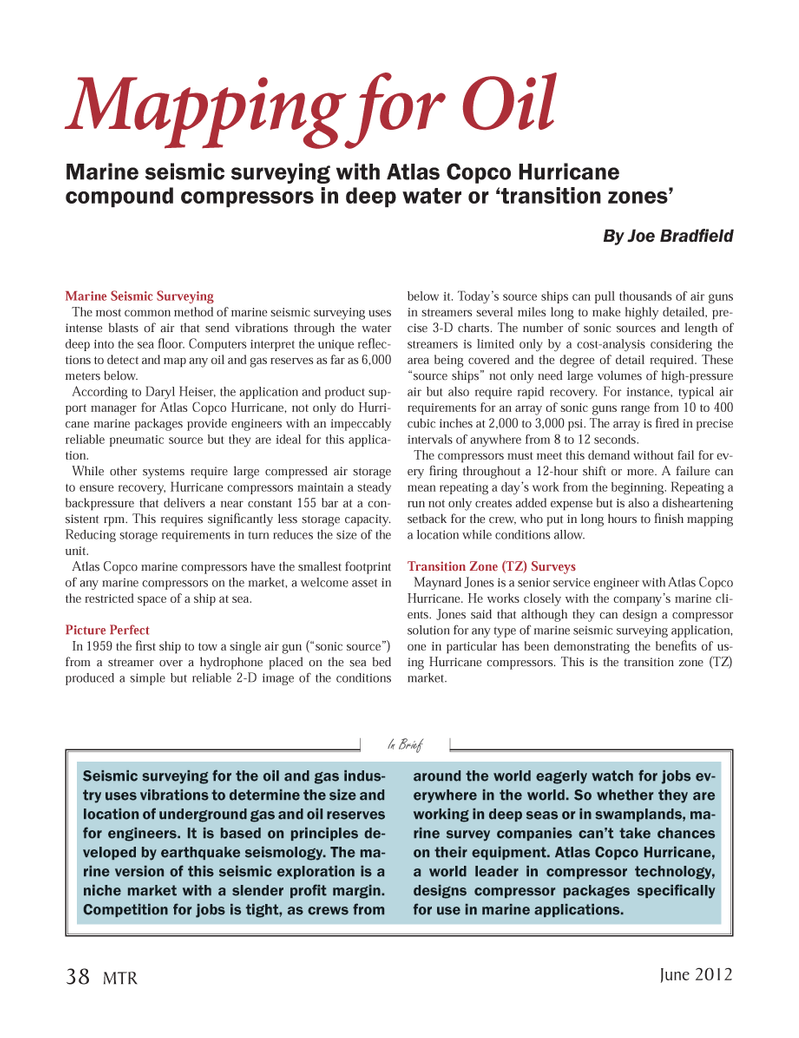
Page 38: of Marine Technology Magazine (June 2012)
AUV Arctic Operations
Read this page in Pdf, Flash or Html5 edition of June 2012 Marine Technology Magazine
Marine Seismic Surveying The most common method of marine seismic surveying uses intense blasts of air that send vibrations through the water deep into the sea ß oor. Computers interpret the unique reß ec-tions to detect and map any oil and gas reserves as far as 6,000 meters below. According to Daryl Heiser, the application and product sup- port manager for Atlas Copco Hurricane, not only do Hurri- cane marine packages provide engineers with an impeccably reliable pneumatic source but they are ideal for this applica- tion. While other systems require large compressed air storage to ensure recovery, Hurricane compressors maintain a steady backpressure that delivers a near constant 155 bar at a con- sistent rpm. This requires signiÞ cantly less storage capacity. Reducing storage requirements in turn reduces the size of the unit. Atlas Copco marine compressors have the smallest footprint of any marine compressors on the market, a welcome asset in the restricted space of a ship at sea.Picture Perfect In 1959 the Þ rst ship to tow a single air gun (Òsonic sourceÓ) from a streamer over a hydrophone placed on the sea bed produced a simple but reliable 2-D image of the conditions below it. TodayÕs source ships can pull thousands of air guns in streamers several miles long to make highly detailed, pre- cise 3-D charts. The number of sonic sources and length of streamers is limited only by a cost-analysis considering the area being covered and the degree of detail required. These Òsource shipsÓ not only need large volumes of high-pressure air but also require rapid recovery. For instance, typical air requirements for an array of sonic guns range from 10 to 400 cubic inches at 2,000 to 3,000 psi. The array is Þ red in precise intervals of anywhere from 8 to 12 seconds. The compressors must meet this demand without fail for ev- ery Þ ring throughout a 12-hour shift or more. A failure can mean repeating a dayÕs work from the beginning. Repeating a run not only creates added expense but is also a disheartening setback for the crew, who put in long hours to Þ nish mapping a location while conditions allow. Transition Zone (TZ) Surveys Maynard Jones is a senior service engineer with Atlas Copco Hurricane. He works closely with the companyÕs marine cli- ents. Jones said that although they can design a compressor solution for any type of marine seismic surveying application, one in particular has been demonstrating the beneÞ ts of us- ing Hurricane compressors. This is the transition zone (TZ) market. Mapping for Oil Marine seismic surveying with Atlas Copco Hurricane compound compressors in deep water or ?transition zones? By Joe BradÞ eld In BriefSeismic surveying for the oil and gas indus- try uses vibrations to determine the size and location of underground gas and oil reserves for engineers. It is based on principles de- veloped by earthquake seismology. The ma- rine version of this seismic exploration is a niche market with a slender pro Þ t margin. Competition for jobs is tight, as crews from around the world eagerly watch for jobs ev- erywhere in the world. So whether they are working in deep seas or in swamplands, ma- rine survey companies can?t take chances on their equipment. Atlas Copco Hurricane, a world leader in compressor technology, designs compressor packages speci Þ cally for use in marine applications. June 201238 MTRMTR #5 (34-49).indd 38MTR #5 (34-49).indd 385/31/2012 10:21:50 AM5/31/2012 10:21:50 AM

 37
37

 39
39
